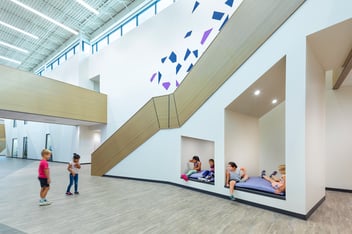 Bullying is a problem, and most schools are combating it by implementing zero-tolerance policies. These policies are intended to promote a more safe and welcoming campus culture. But some are now realizing that in addition to policy buy-ins, specific modern school design strategies can be used to discourage peer-on-peer intimidation. When considering the different benefits of an intelligently designed school, a reduction in bullying probably isn't the first thing that comes to mind. But that's exactly what some schools are experiencing. Let's take a look at some of the things architecture can do to reduce bullying...
Bullying is a problem, and most schools are combating it by implementing zero-tolerance policies. These policies are intended to promote a more safe and welcoming campus culture. But some are now realizing that in addition to policy buy-ins, specific modern school design strategies can be used to discourage peer-on-peer intimidation. When considering the different benefits of an intelligently designed school, a reduction in bullying probably isn't the first thing that comes to mind. But that's exactly what some schools are experiencing. Let's take a look at some of the things architecture can do to reduce bullying...
How Modern School Design can Help Reduce Bullying
most recent

When Architecture Listens: Incorporating Feedback into Educational Designs
True architectural excellence is not solely about imposing a predefined aesthetic or style onto a...

Design Strategies for Maximizing Your School Commons Space
Today, more than ever, the school commons holds the potential to transform our educational...

Designing Classrooms That Support the Future of VR and AR
In today's fast-paced world, education must prepare students for a tech-driven future. As educators...
contact us
Contact us for more information and for all of your project inquiries.
Our offices across Iowa and Nebraska have specialists ready to work on projects throughout the country. Learn more about each office below and reach out to discuss your next project.